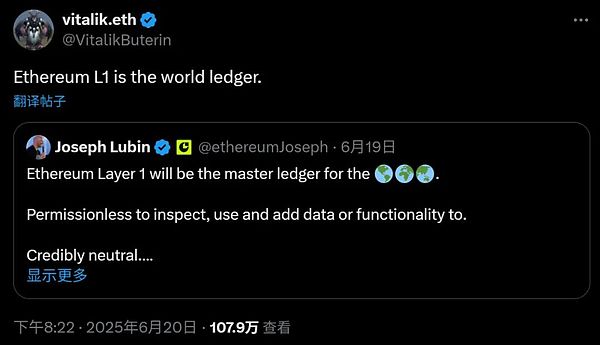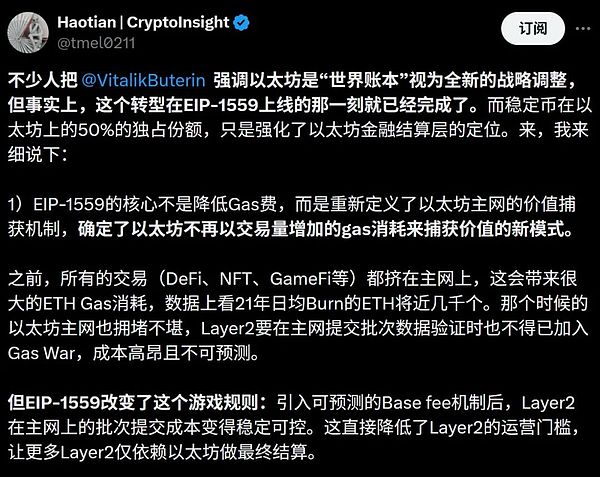On June 20, Ethereum founder Vitalik Buterin reposted a tweet from ConsenSys founder Joseph Lubin, saying that "Ethereum L1 is the world's ledger."

This is also a rare statement by Vitalik regarding the recent macro narrative discussion of Ethereum.
As we all know, in the blockchain world, each public chain basically has a design positioning, which often lays the foundation for its technical architecture and ecological style.
For example, Ethereum, since its birth, has had the ultimate vision of building a "world computer": an open platform that can run any smart contract and carry various Web3 application logics.Vitalik has also clearly pointed out that Ethereum is not only a payment network, but also a general decentralized computing layer.
So now, from "world computer" to "world ledger", what kind of narrative changes has it experienced?
Ethereum: The Original Aspiration of the World Computer
In fact, not only Ethereum, but even Bitcoin, which originally proposed the vision of "Electronic Cash", has gradually faded its payment positioning with the growth of volume and market evolution, and turned to "digital gold" with value storage as the core.
Objectively speaking, this transformation itself is a pragmatic choice. After all, BTC, as a representative of crypto assets breaking out of the circle and breaking the boundary, has been substantially included in the balance sheets of mainstream financial institutions and gradually become one of the core assets configured by TradFi.
Looking back at the development path of Ethereum, we will find that although the main line has not undergone a drastic change in the grand narrative, it has long been in a continuous dynamic evolution:
Since 2016, Ethereum has been the leader of all smart contract platforms, leading the entire track to the birth of a large number of on-chain use cases, from ERC20 to DeFi, to NFT and chain games, each round of hot spots has confirmed the charm of "on-chain computing power".
It can be said that smart contracts have always been its core, so Vitalik has repeatedly emphasized that
Ethereum is a decentralized application platform whose goal is to carry various Web3 native logics, not just asset transfers. But at the same time, we also see contradictions in reality. The most criticized are naturally the performance issues such as high gas fees and low TPS, which have limited the large-scale implementation of truly complex computing logic. It is in this context that Rollup technology has gradually entered the mainstream since 2020. After 5 years of development, Ethereum has gradually established a "L1+L2" layered structure.
Under this architecture, especially in the past two years, more and more signs show that Ethereum is showing signs of becoming a credible, stable, sovereign-level "world ledger".
Narrative reconstruction under the division of labor between L1 and L2
If we use one sentence to summarize this division of labor,"The Ethereum mainnet is responsible for security and settlement, and L2 undertakes high-frequency interactions"should be appropriate.
To put it bluntly, a clear division of labor has been formed within the Ethereum ecosystem, that is, the mainnet is responsible for providing infrastructure guarantees for security and final settlement, while L2 (such as Base, Arbitrum, Optimism, etc.) carries most of the high-frequency transactions and user operations.
This not only improves scalability, but also further strengthens ETH's value capture logic,naturally pushing the Ethereum mainnet to the position of a "global decentralized ledger". The more L2s there are, the more successful they are, the more prosperous the ecosystem is, and the higher the value of the Ethereum mainnet as a unified large ledger.
After all, all L2 networks rely on it as a "central bank" level settlement layer.

As Web3 researcher Haotian said, EIP-1559 is undoubtedly a key node in the turning point of Ethereum's narrative. It not only introduces the Base Fee and burning mechanism, but also deeply reshapes Ethereum's value capture method, making Ethereum no longer rely on the Gas income brought by a large number of transactions on the main network, but instead relies on L2 to achieve continuous "taxation".
In other words, in the past, users were the direct customers of the main network, but now they have become L2 agents, responsible for providing services to users, collecting fees, and finally "handing over" fees to the main network in exchange for settlement rights.This mechanism design is very similar to the "tax farmer system" in history:
The main network becomes the final trusted ledger for transaction clearing and settlement, similar to the central bank;
L2 is like a commercial bank, responsible for high-frequency services for users;
and each L2 transaction will be burned when it returns to the main network for verification. ETH, pays for the security of the ledger;
It can be said that Ethereum has not given up the vision of "world computer", but the L1+L2 division of labor architecture and development path are guiding it to become the "world ledger" first.
The realism of "world ledger"
Another interesting observation dimension is that each round of ETH's value explosion actually stems from the "use" of the main network as a ledger.
Like the ERC20 wave in 2017, which was the clearing and settlement layer for issuing tokens, and the DeFi Summer in 2020, which was the fund settlement platform under the combination of smart contracts, and the recent round of if the tokenization of US stocks and the on-chaining of financial assets such as RWA have exploded again, Ethereum will still be the trusted ledger.
Because for TradFi, computing power is of course important, but what really determines whether to migrate to the chain is always the "trust, finality and security" of the ledger-this is the core foothold of compliant assets.
This is also why platforms like Robinhood have chosen to launch US stock token trading services based on L2 such as Arbitrum. Behind this is not only the recognition of the performance of the Rollup architecture, but more importantly, these transactions will eventually return to the Ethereum mainnet for settlement.
This also shows that the performance, security and compliance capabilities of the existing L2 solution are sufficient to undertake the transaction needs of traditional financial core assets. In a sense, this round of "U.S. stocks on the chain" wave has actually strengthened Ethereum's positioning as a global financial settlement infrastructure, and further verified the feasibility and practical needs of its "world ledger" role.
This is the realistic evolution path of Ethereum from "world computer" to "world ledger" - it no longer just promises the future on-chain application landscape, but is chosen by more and more mainstream assets in the real world as the settlement end point.
From this perspective, this kind of trend is not only a confirmation of the value of Ethereum L1, but will also profoundly reconstruct the value capture logic of L2, and promote the entire Ethereum ecosystem to truly connect technology and financial infrastructure.
In a nutshell, the narratives that can really drive this chain toward hundreds of millions of users are not just about what Ethereum can do, but also about:
what the real world is willing to do with Ethereum.
 Clement
Clement
 Clement
Clement Kikyo
Kikyo Jixu
Jixu Clement
Clement Hui Xin
Hui Xin Catherine
Catherine Clement
Clement Aaron
Aaron Jasper
Jasper Jixu
Jixu